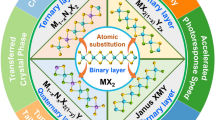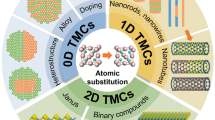Abstract
A first-principles calculation was carried out to investigate the stability and electronic properties of ultra-thin Cx(BN)y heteronanotubes which were composed by joining pure CNT and BNNT segments with different composition and configurations. We found that the stability of Cx(BN)y heteronanotubes is increased with the increasing number of B and N atoms. In addition, all armchair (3,3) Cx|(BN)y heteronanotubes were found to be semiconductors with tunable energy gaps between 0.45 to 1.62 eV. Whereas zigzag (5,0) Cx|(BN)y heteronanotubes can be metal (y ≤ 4) or semiconductor (y > 4), and it is different from the relatively big zigzag Cx|(BN)y heteronanotubes which are always conductors. It indicates that the energy gap of (5,0) Cx|(BN)y heteronanotubes can be tuned by modifying the value of y. Further, zigzag (5,0) and armchair (3,3) C-BN heteronanotubes were found to be metal and semiconductor, respectively; but zigzag and armchair C-BN heteronanotubes with relatively big diameter are always semiconductor and conductor, respectively. Therefore, the electronic properties of ultra-thin Cx(BN)y heteronanotubes are abnormal when comparing with the relatively big ones.
Highlights
• The stability of Cx(BN)y heteronanotubes is increased with the increasing value of y.
• Zigzag (5,0) Cx|(BN)y heteronanotubes can change from metal (y ≤ 4) to semiconductor (y > 4) when the value of y increases from 1 to 7.
• The band gaps of armchair (3,3) Cx|(BN)y heteronanotubes increase from 0.45 to 1.62 eV when the value of y increases from 1 to 7.
• The electronic properties (energy gap) of Cx(BN)y heteronanotubes are tunable and different in comparison with the relatively big ones.

ᅟ







Similar content being viewed by others
References
Iijima S (1991) Helical microtubules of graphitic carbon. Nature 354:56–58
Politzer P, Murray JS, Lane P, Concha MC, Jin P, Peralta-Inga Z (2005) An unusual feature of end-substituted model carbon (6,0) nanotubes. J Mol Model 11:258–264
Ma F, Zhou Z-J, Li Z-R, Wu D, Li Y, Li Z-S (2010) Lithium salt of end-substituted nanotube: structure and large nonlinear optical property. Chem Phys Lett 488:182–186
Zurek E, Autschbach J (2004) Density functional calculations of the 13C NMR chemical shifts in (9,0) single-walled carbon nanotube. J Am Chem Soc 126:13079–13088
Zurek E, Pickard CJ, Autschbach J (2008) Determining the diameter of functionalized single-walled carbon nanotubes with 13C NMR: a theoretical study. J Phys Chem C 112:9267–9271
Wildöer JWG, Venema LC, Rinzler AG, Smalley RE, Dekker C (1998) Electronic structure of atomically resolved carbon nanotubes. Nature 391:59–62
Odom TW, Huang JL, Kim P, Lieb CM (1998) Atomic structure and electronic proper ties of single- walled carbon nanotubes. Nature 391:62–64
Blasé X, Rubio A, Louie SG, Cohen ML (1994) Stability and band Gap of boron nitride nanotubes. Europhys Lett 28:335–340
Xiang HJ, Yang JL, Hou JG, Zhu QS (2003) First-principles study of small-radius single- walled BN nanotubes. Phys Rev B 68:035427
Zhao CY, Bando Y, Tan CC, Golberg D (2005) Effective precursor for high yield synthesis of pure BN nanotubes. Solid State Commun 135:67–70
Wang WL, Bai XD, Liu KH, Xu Z, Golberg D, Bando Y, Wang EG (2006) Direct synthesis of B-C-N single-walled nanotubes by bias-assisted Hot filament chemical vapor deposition. J Am Chem Soc 128:6530–6531
Enouz S, Stéphan O, Cochon JL, Colliex C, Loiseau A (2007) C − BN patterned single- walled nanotubes synthesized by laser vaporization. Nano Lett 7:1856–1862
Enouz-Védrenne S, Stéphan O, Glerup M, Cochon JL, Colliex C, Loiseau A (2008) Effect of the synthesis method on the distribution of C, B, and N elements in multiwall nanotubes: a spatially resolved electron energy loss spectroscopy study. J Phys Chem C 112:16422–16430
Peyghan AA, Hadipour NL, Zargham B (2013) Effects of Al doping and double-antisite defect on the adsorption of HCN on a BC2N nanotube: density functional theory studies. J Phys Chem C 117:2427–2432
Pan H, Feng YP, Lin JY (2006) Ab initio study of single-wall BC2N nanotubes. Phys Rev B 74:045409
Xiao HP, Zhang CX, Zhang KW, Sun LZ, Zhong JX (2013) Tunable differential conductance of single wall C/BN nanotube heterostructure. J Mol Model 19:2965–2969
Saikia N, Deka RC (2012) First principles study on the boron-nitrogen domains segregated within (5,5) and (8,0) single-wall carbon nanotubes: formation energy, electronic structure and reactivity. Comput Theor Chem 996:11–20
Du A, Chen Y, Zhu ZH, Lu GQ, Smith SC (2009) C-BN single-walled nanotubes from hybrid connection of BN/C nanoribbons: prediction byab initio density functional calculations. J Am Chem Soc 131:1682–1683
Guo CS, Fan WJ, Chen ZH, Zhang RQ (2006) First-principles study of single-walled armchair Cx(BN)y nanotubes. Solid State Commun 137:549–552
Zhao P, Liu DS, Chen G (2013) Effect of mono-vacancy on transport properties of zigzag carbon- and boron-nitride-nanotube heterostructures. Solid State Commun 160:13–16
Wang P, Zhang CJ (2010) Doped ways of boron and nitrogen doped carbon nanotubes: a theoretical investigation. J Mol Struct Theochem 955:84–90
Choi J, Kim YH, Chang KJ, Tománek D (2003) Itinerant ferromagnetism in heterostructured C/BN nanotubes. Phys Rev B 67:125421
An W, Turner CH (2010) Linking carbon and boron-nitride nanotubes: heterojunction energetics and band Gap tuning. J Phys Chem Lett 1:2269–2673
Machado M, Kar T, Piquini P (2011) The influence of the stacking orientation of C and BN stripes in the structure, energetics, and electronic properties of BC2N nanotubes. Nanotechnology 22:205706
Moore GE (1965) Cramming more components onto integrated circuits. Electron Mag 38:114–117
Popov VN (2004) Carbon naonotubes: properties and application. Mater Sci Eng R 43:61–102
Derycke V, Martel R, Appenzeller J, Avouris P (2001) Carbon nanotube inter- and intramolecular logic gates. Nano Lett 1:453–456
Bachtold A, Hadley P, Nakanisihi T, Dekker C (2001) Logic circuits with carbon nanotube transistors. Science 294:1317–1320
Shulaker MM, Hills G, Patil N, Wei H, Chen H-Y, Philip Wong H-S, Mitra S (2013) Carbon nanotube computer. Nature 501:526–530
Cabria I, Mintmire JW, White CT (2003) Metallic and semiconductor narrow carbon nanotubes. Phys Rev B 67:121406
Sawada S, Hamada N (1992) Energetics of carbon nano-tubes. Solid State Commun 83:917–919
Peng L-M, Zhang ZL, Xue ZQ, Wu QD, Gu ZN, Pettifor DG (2000) Stability of carbon nanotubes: how small can they be? Phys Rev Lett 85:3249–3252
Qin LC, Zhao XL, Hirahara KR, Miyamoto Y, Ando Y, Iijima S (2000) The smallest carbon nanotube. Nature 408:50
Wang N, Tang ZK, Li GD, Chen JS (2000) Single-walled 4 Å carbon nanotube arrays. Nature 408:50–51
Hayashi T, Kim YA, Matoba T, Esaka M, Nishimura K, Tsukada T, Endo M, Dresselhaus MS (2003) Smallest freestanding single-walled carbon nanotube. Nano Lett 3:887–889
Liu HJ, Chan CT (2002) Properties of 4 Å carbon nanotubes from first-principles calculations. Phys Rev B 66:115416
Delley B (1990) An All-electron numerical method for solving the local density functional for polyatomic molecules. J Chem Phys 92:508–517
Delley B (2000) From molecules to solids with the DMol3 approach. J Chem Phys 113:7756–7764
Perdew JP, Wang Y (1992) Accurate and simple analytic representation of the electron- Gas correlation energy. Phys Rev B 45:13244–13249
Monkhorst HJ, Pack JD (1976) Special points for brillouin-zone integrations. Phys Rev B 13:5188–5192
Li Y-T, Chen T-C (2009) Effect of B/N co-doping on the stability and electronic structure of single-walled carbon nanotubes by first-principles theory. Nanotechnology 20:375705
Nozaki H, Itoh S (1996) Structural stability of BC2N. J Phys Chem Solids 57:41–49
Acknowledgments
This work was supported by the Natural Science Foundation of the Fujian Province of China (grant no. A0220001). We acknowledge the high-performance computing platform of South China Normal University for financial support.
Author information
Authors and Affiliations
Corresponding author
Rights and permissions
About this article
Cite this article
Wang, Y., Huang, G., Zhang, J. et al. Tunable electronic properties of ultra-thin boron-carbon-nitrogen heteronanotubes for various compositions. J Mol Model 20, 2371 (2014). https://doi.org/10.1007/s00894-014-2371-9
Received:
Accepted:
Published:
DOI: https://doi.org/10.1007/s00894-014-2371-9




